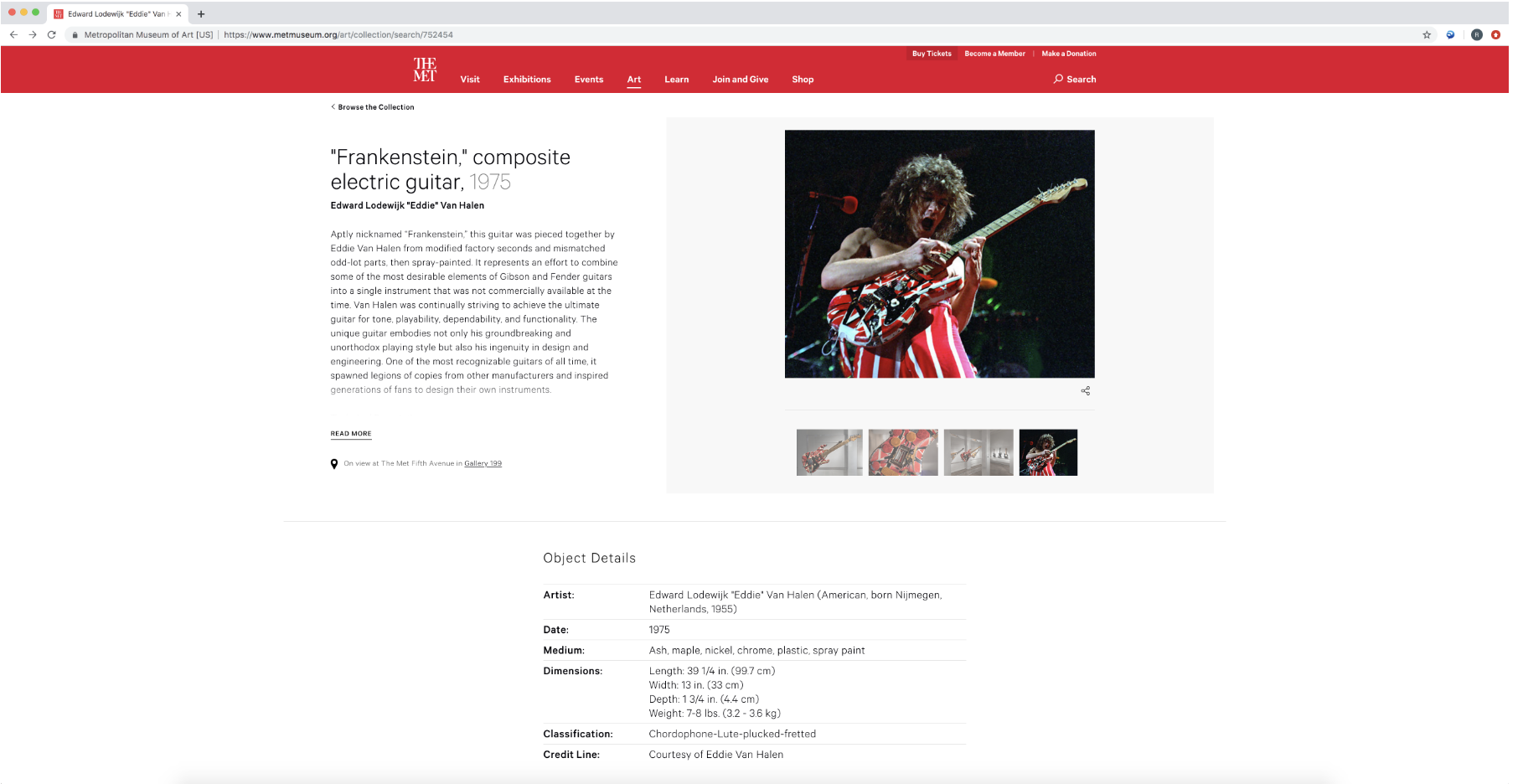“Marano argued that a holding in favor of fair use ‘would extinguish copyright protections for photographers because museums displaying copyrighted photographs will always be able to assert a fair use defense by claiming a scholarly, transformative purpose behind the exhibition.’ However, the court said the fair use inquiry has always been ‘an open-ended and context-sensitive inquiry.’”

Source: court documents
On Friday, April 2, the United States Court of Appeals for the Second Circuit issued a Summary Order affirming a district court’s finding that the Metropolitan Museum of Art’s use of a photographer’s photo on its website to illustrate a museum exhibit constituted a fair use.
The photo was taken by Lawrence Marano in 1982 and depicted Eddie Van Halen playing his iconic “Frankenstein” guitar. The Metropolitan Museum featured the photograph on its website as part of an exhibit of rock n’ roll instruments. Marano initially brought his complaint against the museum in the United States District Court for the Southern District of New York in 2019, and the court dismissed it in 2020 for failure to state a claim, “finding that Marano had ‘failed to show why the Met’s use of [the Photo] is not protected by the fair use exception.’”
On appeal to the Second Circuit, Marano challenged that determination, but, after considering the four fair use factors—which are in the spotlight this week following the Google v. Oracle Supreme Court ruling—the Second Circuit found that all four factors as applied to the facts of the case weighed in favor of fair use. The four factors are:
- The purpose and character of the use;
- The nature of the copyrighted work;
- the amount and substantiality of the portion used in relation to the copyrighted work as a whole; and
- the effect of the use upon the potential market for or value of the copyrighted work.
Focusing chiefly on the first factor, which the appeals court noted has been framed as the “heart of the fair use inquiry,” the court found the museum’s use “transformative.” The exhibition transformed the photo “by foregrounding the instrument rather than the performer” and highlighted the guitar, rather than Van Halen, said the court. The photo also appeared on the website beside other photos of the guitar and accompanied by text discussing its history, genesis and impact on rock’n roll, which imparts a different character or purpose, added the court.
Despite Marano’s argument that the use was not sufficiently transformative, in part because the Met charges admission and provides entertainment, the court said that the museum is primarily a nonprofit that charges a “nominal fee to out-of-state visitors,” while the website is free to all. “These purposes are not commercial; to the contrary, they align the Met’s fair use of the Photo with ‘copyright’s very purpose, ‘[t]o promote the Progress of Science and useful Arts,’” said the court. There is also no evidence that the museum’s use of the photo could impair any other market for commercial use of the photo or diminish its value.
Marano argued that a holding in favor of fair use “would extinguish copyright protections for photographers because museums displaying copyrighted photographs will always be able to assert a fair use defense by claiming a scholarly, transformative purpose behind the exhibition.”
However, the court said the fair use inquiry has always been “an open-ended and context-sensitive inquiry” and that the district court “appropriately conducted a fair-use analysis that was ‘deeply case-specific,’ such that “ [a] different use by a museum or art exhibition and combination of factors could have tipped the scales in the other direction.” The appeals court thus saw no error in the district court’s analysis and affirmed the judgment.
In a statement made to Artnet News, Linda Steinman, an attorney for the Met, said the decision “is an important one recognizing that museums, as cultural institutions, have the freedom to use photographs that are historical artifacts to enrich their presentation of art objects to the public.”

![[IPWatchdog Logo]](https://ipwatchdog.com/wp-content/themes/IPWatchdog%20-%202023/assets/images/temp/logo-small@2x.png)


![[Advertisement]](https://ipwatchdog.com/wp-content/uploads/2024/04/Patent-Litigation-Masters-2024-sidebar-early-bird-ends-Apr-21-last-chance-700x500-1.jpg)

![[Advertisement]](https://ipwatchdog.com/wp-content/uploads/2021/12/WEBINAR-336-x-280-px.png)
![[Advertisement]](https://ipwatchdog.com/wp-content/uploads/2021/12/2021-Patent-Practice-on-Demand-recorded-Feb-2021-336-x-280.jpg)
![[Advertisement]](https://ipwatchdog.com/wp-content/uploads/2021/12/Ad-4-The-Invent-Patent-System™.png)







Join the Discussion
One comment so far.
Anon
April 6, 2021 03:09 pmAn exception that swallows the rule (and yet another example of a desired Ends achieved by any Means).
I do have to wonder though, if the largess being heaped on the phrase “transformative” will find its way into the mirror of Article 1 Section 8 Clause 8 – specifically as to transforming an item (and not necessarily a physical item) into a different state or thing.